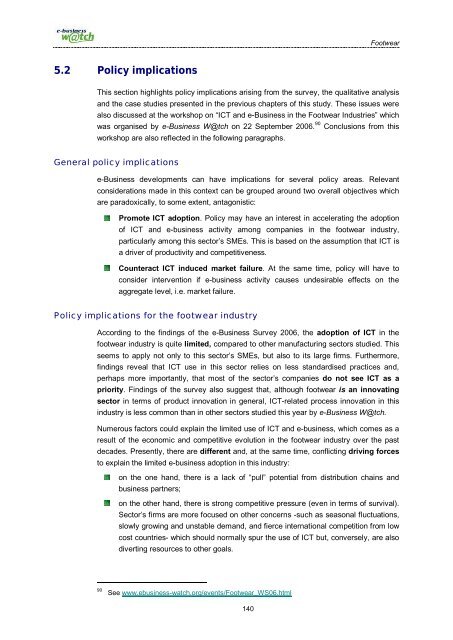Footwear Industry Footwear Industry - empirica
Footwear Industry Footwear Industry - empirica
Footwear Industry Footwear Industry - empirica
Create successful ePaper yourself
Turn your PDF publications into a flip-book with our unique Google optimized e-Paper software.
<strong>Footwear</strong><br />
5.2 Policy implications<br />
This section highlights policy implications arising from the survey, the qualitative analysis<br />
and the case studies presented in the previous chapters of this study. These issues were<br />
also discussed at the workshop on “ICT and e-Business in the <strong>Footwear</strong> Industries” which<br />
was organised by e-Business W@tch on 22 September 2006. 90 Conclusions from this<br />
workshop are also reflected in the following paragraphs.<br />
General policy implications<br />
e-Business developments can have implications for several policy areas. Relevant<br />
considerations made in this context can be grouped around two overall objectives which<br />
are paradoxically, to some extent, antagonistic:<br />
Promote ICT adoption. Policy may have an interest in accelerating the adoption<br />
of ICT and e-business activity among companies in the footwear industry,<br />
particularly among this sector’s SMEs. This is based on the assumption that ICT is<br />
a driver of productivity and competitiveness.<br />
Counteract ICT induced market failure. At the same time, policy will have to<br />
consider intervention if e-business activity causes undesirable effects on the<br />
aggregate level, i.e. market failure.<br />
Policy implications for the footwear industry<br />
According to the findings of the e-Business Survey 2006, the adoption of ICT in the<br />
footwear industry is quite limited, compared to other manufacturing sectors studied. This<br />
seems to apply not only to this sector’s SMEs, but also to its large firms. Furthermore,<br />
findings reveal that ICT use in this sector relies on less standardised practices and,<br />
perhaps more importantly, that most of the sector’s companies do not see ICT as a<br />
priority. Findings of the survey also suggest that, although footwear is an innovating<br />
sector in terms of product innovation in general, ICT-related process innovation in this<br />
industry is less common than in other sectors studied this year by e-Business W@tch.<br />
Numerous factors could explain the limited use of ICT and e-business, which comes as a<br />
result of the economic and competitive evolution in the footwear industry over the past<br />
decades. Presently, there are different and, at the same time, conflicting driving forces<br />
to explain the limited e-business adoption in this industry:<br />
on the one hand, there is a lack of “pull” potential from distribution chains and<br />
business partners;<br />
on the other hand, there is strong competitive pressure (even in terms of survival).<br />
Sector’s firms are more focused on other concerns -such as seasonal fluctuations,<br />
slowly growing and unstable demand, and fierce international competition from low<br />
cost countries- which should normally spur the use of ICT but, conversely, are also<br />
diverting resources to other goals.<br />
90<br />
See www.ebusiness-watch.org/events/<strong>Footwear</strong>_WS06.html<br />
140

















